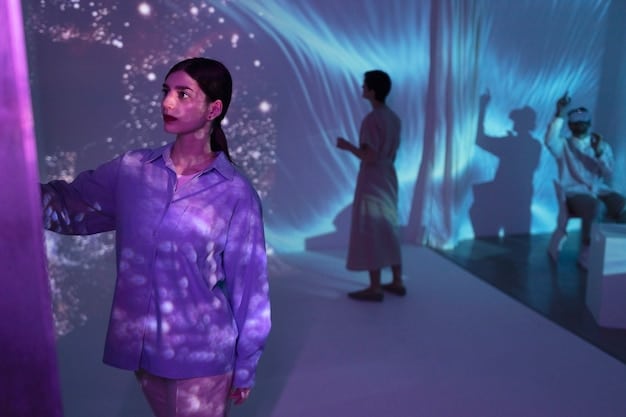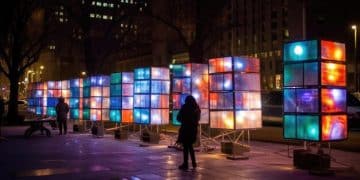The Rise of Immersive Art Experiences: Are They Worth the Ticket Price? A Comparative Analysis

A comparative analysis of immersive art experiences reveals their burgeoning presence, questioning if their premium ticket price is justified by unique value offerings in a rapidly evolving cultural landscape.
In a world increasingly saturated with digital distractions, a fascinating phenomenon is captivating audiences: the rise of immersive art experiences. These aren’t your grandmother’s quiet museum visits; rather, they are dynamic, multi-sensory spectacles designed to transport viewers into new realms. But as these experiences proliferate, often commanding premium prices, a crucial question emerges for enthusiasts and casual observers alike: Are they worth the ticket price? This article delves into a comparative analysis, exploring the value proposition of these captivating new forms of artistic engagement, focusing on The Rise of Immersive Art Experiences: Are They Worth the Ticket Price? A Comparative Analysis.
the allure of immersive art
The concept of immersive art is not entirely new, but its recent surge in popularity marks a significant shift in how art is consumed and experienced. Historically, art viewing has often been a contemplative, detached affair, with works displayed in static environments. Immersive art shatters this traditional barrier, inviting active participation and enveloping the viewer within the artistic narrative. This fundamental difference is a key part of its appeal, drawing in diverse audiences who might find conventional art spaces less engaging.
sensory overload in a good way
One of the primary drivers behind the allure of immersive art is its multi-sensory nature. Unlike flat canvases or static sculptures, these installations often engage sight, sound, and sometimes even touch and smell, creating a holistic experience. This approach transforms passive observation into an active engagement, allowing individuals to step inside the artwork rather than merely standing before it. Imagine a room where the walls pulse with light, soundscapes shift with your movement, and projections respond to your presence. This level of interaction can create a profound sense of wonder and connection that a traditional art piece might struggle to evoke.
- Visual Spectacle: Large-scale projections, intricate light displays, and dynamic digital art create breathtaking environments.
- Auditory Immersion: Custom-designed soundscapes, musical scores, and ambient noises enhance the emotional impact and narrative.
- Tactile and Olfactory Elements: Some experiences incorporate textures, scents, or even subtle air movements to further deepen the sensory journey.
- Interactive Components: Viewers might trigger changes in the environment, becoming part of the artwork’s evolving story.
This sensory richness taps into a desire for experiences that go beyond the ordinary. In an age where digital content is often two-dimensional, immersive art offers a tangible, ‘real-life’ escape that feels uniquely potent. The novelty factor plays a significant role, as each new exhibit often promises a never-before-seen blend of technology, creativity, and storytelling. For many, it’s not just about seeing art; it’s about feeling it, living it, and being part of it. This active participation often leads to a more memorable and shareable experience, contributing to the viral appeal that many of these exhibitions achieve on social media platforms. The sheer scale and ambition of these projects often make them destinations in themselves, justifying travel and planning to attend.
the economic landscape of immersive experiences
Understanding the financial model behind immersive art experiences is crucial when evaluating their ticket prices. These aren’t low-cost ventures. They often require significant investment in cutting-edge technology, vast physical spaces, specialized artistic talent, and complex logistical planning. From high-definition projectors and elaborate sound systems to sophisticated motion sensors and custom software, the technical infrastructure alone can be staggering. Add to this the cost of renting or purchasing large venues, marketing campaigns, and hiring skilled staff, and it becomes clear why production costs run high.
production costs and pricing strategy
The sophisticated nature of these installations means they are expensive to produce, maintain, and transport. Unlike a painting that can be hung on a wall, an immersive exhibit might involve dismantling, packing, and reassembling hundreds of components. This logistical complexity directly impacts operational expenses. Consequently, ticket prices are set to recoup these substantial investments and generate a profit, often operating more like a theatrical production or a high-end entertainment event than a traditional museum exhibition. The pricing strategy also reflects the perceived value and exclusivity, particularly for limited-run or highly anticipated shows.
the supply and demand dynamic
The demand for these experiences has soared, particularly among younger generations and those seeking ‘Instagrammable’ moments. This high demand, coupled with the relatively limited supply of truly high-quality immersive shows (due to their complexity and cost), allows organizers to charge premium prices. Early-bird tickets, VIP packages, and timed entry slots are common strategies to manage demand and optimize revenue. The perceived scarcity of these unique events often adds to their allure, prompting consumers to view a higher ticket price as a necessary investment for a once-in-a-lifetime opportunity. It’s a classic economic interplay where strong consumer desire meets a specialized, high-cost supply.
The economic model is also influenced by the temporary nature of many immersive art shows. Unlike permanent museum collections, these exhibitions often run for a few months or a year in a particular city before moving on or closing down. This fleeting presence creates a sense of urgency, encouraging prompt ticket purchases. The financial viability relies heavily on filling these temporary slots, necessitating rapid sales at optimized price points to cover the large upfront costs. This temporal scarcity, combined with effective marketing that highlights the unique nature of each show, helps cultivate an environment where higher prices are not just tolerated, but often expected and accepted by the targeted audience.
traditional art vs. immersive art: a comparative lens
Comparing traditional art forms with immersive experiences is not about declaring one superior but understanding their distinct aims and impacts. Traditional art, whether painting, sculpture, or photography, typically offers a static, contemplative experience. The viewer observes from a distance, interprets, and reflects. The interaction is primarily intellectual and emotional, often facilitated by placards or audioguides. The value here lies in the artist’s skill, the historical context, and the individual’s personal connection to the work.
engagement and accessibility
Immersive art, by design, seeks active engagement. It prioritizes sensory input and often encourages physical interaction. This can make art more accessible to wider audiences, including those who might feel intimidated by conventional galleries or museums. The playful, technology-driven nature of many immersive shows can lower the barrier to entry, transforming art viewing into a fun, social event. While traditional art often demands a certain level of art historical knowledge or an acquired taste for appreciation, immersive art often appeals universally through its immediate sensory impact.
- Traditional Art: Offers deep contemplation, historical context, and often requires active interpretation by the viewer. Value is in originality and mastery.
- Immersive Art: Provides immediate sensory connection, often encourages interaction, and prioritizes a shared, dynamic experience. Value is in innovation and spectacle.
The differences also extend to their longevity and replicability. A traditional painting maintains its integrity and value over centuries, often appreciating. Immersive experiences, being highly technical, may be more transient. They rely on functioning technology, specific environments, and often cannot be easily replicated over long periods or in diverse settings without significant overhaul. This contributes to the ‘limited time only’ appeal but introduces questions about their enduring artistic legacy compared to durable traditional mediums. The ephemeral nature of many immersive exhibits means that while they offer intense, memorable, albeit temporary, experiences, they don’t contribute to a permanent collection in the same way traditional art does. This distinction is vital when discussing long-term societal value versus immediate personal gratification.
the “worth” factor: evaluating ticket value
Determining whether an immersive art experience is “worth” its ticket price is deeply subjective, yet several factors can help guide this assessment. For some, the cost is immediately justified by the novelty, the sheer sensory pleasure, and the unique photo opportunities. These experiences often become social media events, and for many, the sharable content they provide adds significant value. The memory of being transported and the unique story to tell can also outweigh the monetary cost.
experience vs. exhibition
It’s crucial to consider these events less as traditional exhibitions and more as multi-faceted experiences. They often combine elements of a concert, a theatrical play, a light show, and a digital gallery. When viewed through this lens, the price point might align more closely with other forms of premium entertainment. A concert ticket for a popular artist can easily exceed $100, as can a Broadway show. If an immersive art experience provides a comparable level of entertainment, production quality, and lasting memory, then its higher price might be more palatable.
considerations for value
The ‘worth it’ calculation often comes down to individual expectations and financial capacity. A casual art lover might find a $50 ticket steep if they compare it to a free museum visit, but an ardent fan of innovative art or someone seeking a unique date night might find it a bargain. It also depends on the quality of the specific experience. Not all immersive shows are created equal; some deliver truly groundbreaking, unforgettable moments, while others may feel derivative or less engaging, impacting their perceived value.
The return on investment for an immersive art experience extends beyond mere monetary value. For many, it’s an investment in a memorable moment, a shared experience with loved ones, or an opportunity to escape the mundane. The ‘worth’ is often tied to the narrative power of the exhibition, its ability to evoke strong emotions, or its sheer artistic audacity. When an experience manages to truly transport and transform the viewer, leaving a lasting impression, the ticket price often fades into insignificance, becoming a small fee for a profound personal journey. The unique nature of these events also means they are less likely to be forgotten, adding to their long-term value in personal memory.

case studies: success stories and cautionary tales
Examining specific examples provides critical insight into the varying success and impact of immersive art experiences. The “Van Gogh Immersive Experience” and “ARTECHOUSE” are prominent examples that have captivated global audiences, showcasing the genre’s immense potential when executed well. These experiences often blend art, technology, and narrative in ways that resonate deeply with visitors. Their success hinges on a combination of innovative content, effective marketing, and a keen understanding of audience desires for engagement and spectacle.
the van gogh phenomenon
The “Van Gogh Immersive Experience” is perhaps one of the most widely recognized success stories, touring cities worldwide. Its appeal lies in taking iconic, beloved artworks and breathing new, dynamic life into them through massive floor-to-ceiling projections, accompanied by powerful classical music. Viewers are quite literally enveloped by Van Gogh’s brushstrokes, seeing details and flows they might miss in a traditional gallery setting. This recontextualization makes classic art feel fresh and contemporary, attracting both art aficionados and newcomers. The overwhelming positive response underlines the public’s eagerness for art that feels active rather than passive.
artechouse and the digital frontier
ARTECHOUSE, with permanent locations in cities like Washington D.C., New York, and Miami, represents another successful model. They focus on original, large-scale digital art installations from contemporary artists, often pushing the boundaries of technology to create truly interactive and transformative environments. Their exhibits are less about reinterpreting existing art and more about presenting new, digitally native works that fully leverage the immersive format. This pioneering approach has established them as leaders in the field, demonstrating that ground-up digital immersive art can also attract a dedicated following and justify premium pricing.
However, not all ventures achieve such triumphs. Some immersive experiences, particularly those lacking strong artistic vision, high production values, or genuine interactivity, have fallen flat. These cautionary tales often highlight common pitfalls: bland content, technical glitches, overcrowding that diminishes the ‘immersive’ feeling, or simply failing to deliver a compelling narrative. When an experience feels like a cheap imitation or a mere collection of projections without substance, visitors quickly deem the ticket price unjustified, leading to negative word-of-mouth and poor reviews. The key differentiator often lies in the commitment to genuine artistic innovation and flawless execution, rather than merely relying on the ‘immersive’ label.
the future of immersive art: trends and predictions
The landscape of immersive art is dynamic, constantly evolving with technological advancements and shifting audience expectations. Looking ahead, several key trends are likely to shape its trajectory, influencing both its artistic direction and its economic viability. The integration of more sophisticated technology, a greater emphasis on personalized experiences, and a deeper exploration of thematic content are all on the horizon.
technological leaps and bounds
Expect to see ongoing innovation in projection mapping, augmented reality (AR), and virtual reality (VR). While VR has been somewhat niche, its integration into larger physical spaces for collective experiences could unlock new forms of immersion. Haptic feedback, scent dispensers, and even climate control could also become more commonplace, deepening the sensory engagement. The goal will be to create environments that are not just visually stimulating but truly transportive, blurring the lines between the digital and physical worlds. The fidelity and responsiveness of interactive elements will also improve significantly, making the experience more seamless and intuitive.
personalization and participation
The future of immersive art likely involves more personalized and adaptive experiences. Imagine an exhibit that subtly shifts its narrative or visual elements based on your interaction patterns, emotional responses (perhaps tracked via wearable tech), or even pre-programmed choices. This level of customization would make each visit unique and profoundly engaging. Furthermore, expect more collaborative and participatory elements, where visitors don’t just observe but actively contribute to the evolving artwork, creating a deeper sense of ownership and connection. The shift from passive viewer to active co-creator will be a defining characteristic.
- Hyper-real Environments: Utilizing advanced optics and AI to render environments that are almost indistinguishable from reality.
- Narrative Complexity: Moving beyond purely aesthetic displays to tell richer, more complex stories that unfold around the viewer.
- Sustainable Practices: A growing focus on eco-friendly production methods and reusable materials to minimize environmental impact.
- Cross-Disciplinary Collaborations: More partnerships between artists, technologists, scientists, and even psychologists to create multi-layered sensory and intellectual experiences.
Ultimately, the future success of immersive art experiences will hinge on their ability to deliver genuine value beyond mere spectacle. As the novelty wears off, audiences will demand more substance, originality, and profound artistic expression. Those experiences that manage to harness technology in service of compelling storytelling and meaningful engagement will be the ones that continue to thrive and justify their premium ticket prices. The focus will progressively shift from ‘what’ the technology can do, to ‘how’ it can enhance artistic narrative and human connection. This evolution promises richer, more impactful, and truly unforgettable experiences for years to come.

making an informed decision: is it for you?
Deciding whether to invest in an immersive art experience ultimately boils down to individual preference and what you seek from an artistic encounter. There’s no universal ‘yes’ or ‘no’ answer to the question of whether they are worth the ticket price. Instead, it involves weighing your personal interests, financial comfort, and expectations against what these innovative shows promise to deliver. Understanding the nuances of these experiences can help you make a more informed choice, ensuring your investment aligns with your expectation of value.
factors to consider before buying a ticket
Before purchasing a ticket, take a moment to research the specific experience you’re considering. Look beyond the flashy advertisements. Read reviews from trusted critics and, just as importantly, from recent attendees. Are the reviews consistently positive, highlighting engaging content and smooth operations, or do they frequently mention long lines, technical glitches, or a lack of substance? Consider the artist or collective behind the exhibition; do they have a reputation for quality and innovation? Factors such as the duration of the experience, its location, and any additional costs (e.g., parking, food, merchandise) should also be factored into your decision.
your personal equation of value
Think about what you value most in an art experience. If you crave intense sensory stimulation, a chance to interact with art in new ways, and unique photo opportunities, an immersive experience might be precisely what you’re looking for. If you prefer quiet contemplation, deep historical context, and a focus on singular masterpieces, traditional museums might offer a more satisfying experience. The ‘worth’ is subjective; for some, the ticket price represents a small investment in a memorable event, an escape from the everyday, or a chance to partake in a cutting-edge cultural phenomenon. For others, it might feel like an expense that doesn’t justify the return in personal fulfillment.
The best approach is often to go in with an open mind and realistic expectations. Understand that these are often large-scale productions designed to entertain and provoke a sense of wonder. If you view them as part art exhibition and part entertainment spectacle, you are more likely to find value. The experience is not just about the art itself, but the entire journey—from stepping into the unique environment to sharing the moment with others and recalling the impact long after. Ultimately, the decision to splurge on one of these increasingly popular events rests with you and what you deem to be truly valuable and enriching for your cultural pursuits.
| Key Aspect | Brief Description |
|---|---|
| ✨ Novelty & Immersion | Multi-sensory engagement provides a unique, memorable experience beyond traditional art. |
| 💸 Cost & Value | High production costs lead to premium prices, often comparable to other entertainment forms. |
| 🎨 Art vs. Experience | More than an exhibit, it’s a dynamic, interactive spectacle, appealing to broader audiences. |
| 🔮 Future Trends | Continued technological integration and personalization will shape future immersive art. |
frequently asked questions
▼
Immersive art experiences are multi-sensory installations designed to envelop the viewer within the artwork. Unlike traditional art, they often use large-scale projections, soundscapes, and interactive elements to create a dynamic environment where the audience becomes part of the art, transforming passive viewing into active participation and exploration.
▼
Their higher cost reflects significant investments in cutting-edge technology, large venue rentals, complex production, and specialized artistic talent. These are often temporary installations requiring constant maintenance and elaborate setup/dismantling, positioning them more akin to high-production theatrical shows or concerts than static museum exhibits in terms of pricing structure.
▼
While their primary focus is often on sensory engagement and entertainment, many immersive experiences, especially those based on historical artists (like Van Gogh), can introduce art to new audiences and foster curiosity. They can serve as engaging entry points, prompting further exploration of traditional art forms and the artists’ historical contexts, thereby offering a different kind of educational value.
▼
Research is key. Look for detailed reviews from reputable sources and recent visitors, focusing on aspects like artistic vision, technical execution, overall flow, and crowd management. Consider the artist or collective’s reputation. A truly high-quality experience offers a seamless blend of technology, creativity, and a compelling narrative, ensuring it delivers on its promise of immersion and value.
▼
Generally, yes. Many immersive art experiences are designed to appeal to a broad demographic, including families and children, due to their engaging and interactive nature. However, it’s advisable to check the specific exhibit’s content warnings or age recommendations, as some might feature intense sounds, flashing lights, or themes that might be less suitable for very young children or sensitive individuals.
embracing the evolving canvas
The burgeoning trend of immersive art experiences signals a profound evolution in how we interact with and perceive artistic expression. It shifts the paradigm from detached observation to active participation, transforming passive viewers into integral components of the art itself. While the question of their worth often circles back to individual preferences and the perceived value of a multi-sensory spectacleversus a quiet contemplation, it’s undeniable that these experiences are carving out a significant niche in the cultural landscape. They are not merely temporary fads but innovative platforms pushing the boundaries of creativity and technology, offering unique, memorable encounters that resonate deeply with modern audiences. As technology advances and artists continue to experiment, immersive art is poised to redefine our understanding of engagement, entertainment, and the very essence of artistic connection, inviting us all to step inside the canvas.





